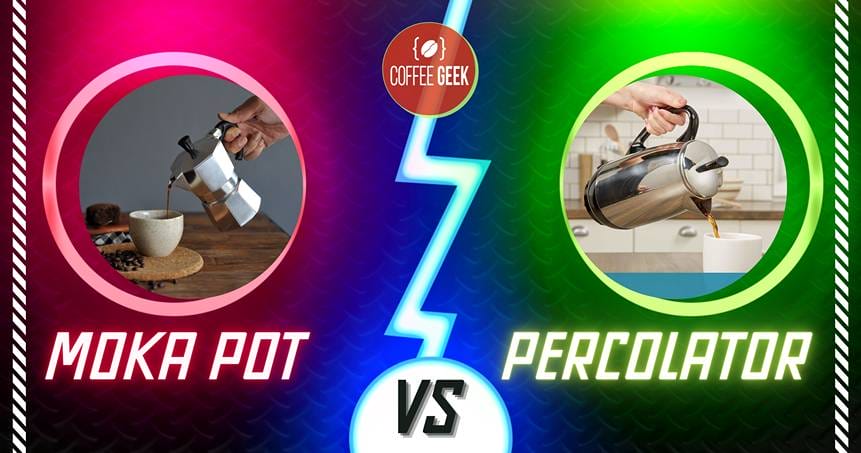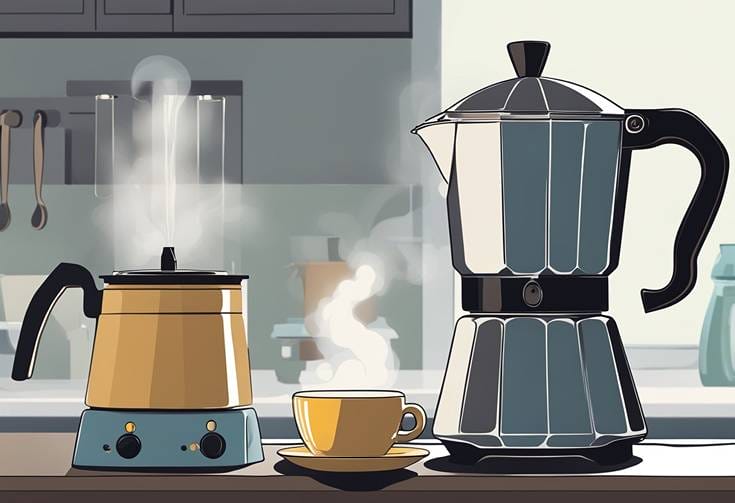When it comes to brewing a rich and flavorful coffee at home, you might be wondering which classic brewing method is best for you: the moka pot or the percolator?
These two methods have been used in households for generations, and each has its unique charm that appeals to coffee enthusiasts worldwide.
The choice between the two largely depends on your preferences, the taste you desire, and the type of coffee you enjoy.
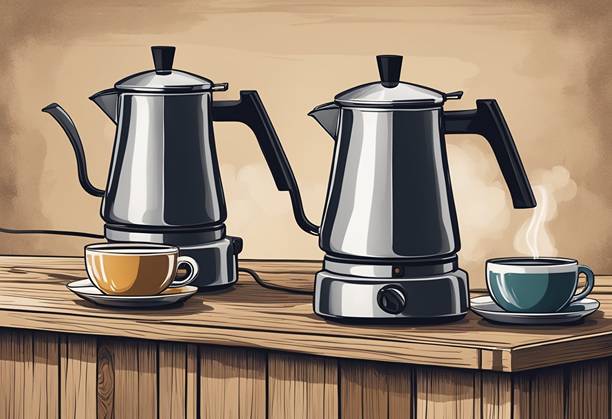
The moka pot, invented in Italy in the 1930s, is known for producing strong coffee that’s comparable to espresso.
On the other hand, the percolator, popularized in the early 20th century, offers a more straightforward brewing process that delivers coffee with regular strength and an unmistakable aroma.
Understanding the fundamental differences between the moka pot and percolator can help you decide which one will suit your needs and deliver the coffee experience you crave.
Key Takeaways
- Moka pots and percolators are distinctive in design and brewing methods, each catering to different taste preferences.
- The durability, ease of usability, and cost are important factors when selecting the perfect coffee maker.
- Understand the pros and cons of each device to determine which will fit your coffee goals and personal preferences.
- Moka Pot vs Percolator: History and Origins
- Design and Working Mechanism
- Brewing Methods Compared
- Taste and Flavor Profile
- Types of Coffee You Can Make
- Usability and Maintenance
- Materials and Durability
- Comparing Cost and Value
- Versatility and Adaptability
- Advantages and Disadvantages
- Conclusion
- Frequently Asked Questions
Moka Pot vs Percolator: History and Origins

Moka Pot History
Moka pots have a fascinating history that merges Italian culture and engineering innovation. Invented by Alfonso Bialetti, an Italian engineer, in 1933, the Moka pot revolutionized the way people brewed coffee.
Bialetti’s invention allowed families to enjoy delicious espresso without having to visit a café; instead, they could prepare it in the comfort of their own homes.
The Moka pot’s unique design, featuring an aluminum stove-top container, is inspired by traditional Italian artistry.
It works by pushing pressurized warm water through finely-ground coffee, resulting in a strong and flavorful brew.
Today, Moka pots are still widely popular, and Bialetti’s company, Bialetti, has become an international leader in the coffee industry.
Percolator History
The percolator also boasts a rich history, with its roots in 19th-century America. Unlike the Moka pot, the percolator was not invented by a single individual but rather evolved over time.
It began with a Parisian tinsmith named Joseph-Henry-Marie Laurens in 1819, who laid the foundation for the continuous heating cycle that defines percolation.
However, it wasn’t until 1889 when Hanson Goodrich, an American farmer, patented the modern design for the stovetop percolator that we know today.
Percolators gained widespread popularity in America, particularly in the 20th century.
Their functionality makes them not only ideal for home use, but also perfect for camping and outdoor adventures.
Percolators work by cycling boiling water through coffee grounds, allowing hot water vapor to slowly trickle through medium-ground coffee.
The result is a full-bodied and bold coffee that many people still enjoy today.
The percolator’s historical connection with American culture remains strong, while Moka pots continue to be iconic symbols of Italian coffee heritage.
Design and Working Mechanism

In this section, you’ll discover the fascinating world of Moka Pots and Percolators.
You’ll learn how they work, what makes them unique, and how to brew delicious coffee with these amazing devices. Let’s dive in!
Understanding Moka Pots
Moka Pots, also known as stovetop espresso makers, are an exciting way to brew coffee at home.
They have a distinctive design, typically made of aluminum or stainless steel, and consist of three main parts:
- Bottom chamber: for water
- Coffee filter basket: for holding finely-ground coffee
- Top chamber: for collecting the brewed espresso
The magic of the Moka Pot lies in its steam pressure brewing process.
As you heat the water in the bottom chamber, it generates steam and builds pressure.
When the pressure becomes strong enough, it forces the hot water through your coffee grounds and coffee in the top chamber.
Voilà! Your bold and delicious espresso is ready to enjoy.
Understanding Percolators
On the other hand, percolators offer a more traditional approach to brewing coffee using gravity as their driving force.
Percolators come in two main types: electric and stovetop.
While they may differ in their heating methods, they share a similar structure:
- Water reservoir: for filling with water
- Filter basket: for medium-ground coffee
- Lid: covers the filter basket and reservoir
The brewing process in a percolator is simple yet effective. As the water heats up, it moves up a central tube before trickling down through the coffee grounds held in the filter basket.
The brewed coffee then collects in the bottom reservoir, continuing to circulate through the grounds until the desired strength is reached.
In summary, while both Moka Pots and Percolators create delicious coffee, they use different mechanisms to do so. Moka Pots utilize steam pressure, while Percolators rely on gravity and continuous circulation.
So grab your favorite brewing device, and enjoy the perfect cup of coffee – tailored just for you!
Brewing Methods Compared

In this section, we’ll dive into the exciting world of brewing methods comparing the Moka Pot and Percolator!
Get ready to learn the key differences and how each method impacts your coffee’s taste and texture.
Moka Pot Brewing Process
The Moka Pot is a compact, easy-to-use stovetop coffee maker that creates a strong, rich cup of coffee.
It operates using pressure and steam to extract flavor from the coffee grounds.
Here’s a brief rundown of how the Moka Pot brewing process works:
- Fill the lower chamber with cold water just below the safety valve.
- Place finely-ground coffee in the filter basket and level it off.
- Assemble the Moka Pot and place it on a heat source.
- The heat generates steam and pressure which forces water through the coffee grounds and up into the upper chamber.
This process results in an intense, concentrated coffee that’s often compared to espresso.
You’ll get consistent extraction and a quick brewing time of around 4-6 minutes.
Remember that over-extracting may lead to bitterness, so it’s important to use the right grind size and not overfill the basket.
Percolator Brewing Process
Percolators are fascinating coffee makers that are a bit more complex, but they reward you with a stronger cup of coffee.
The Percolator brewing process uses a filter basket and utilizes gravity for coffee brewing.
Follow these steps to make your perfect cup:
- Fill the bottom chamber with boiling water.
- Place medium-ground coffee in the filter basket (avoid overfilling).
- Assemble the Percolator and place it on a heat source.
- The water will percolate up through the coffee grounds and drip back down in a continuous cycle.
The Percolator’s consistent cycling of water through the grounds can sometimes lead to over-extraction if the brewing time is too long. Be cautious of that to avoid undesirable bitterness in your coffee.
The brewing time for a percolator can vary, but it typically takes around 8-10 minutes for a delightful cup of coffee.
Now that you’re knowledgeable about the brewing processes of Moka Pots and Percolators, feel empowered to experiment and find your ideal brewing method! Enjoy your coffee journey, and happy brewing!
Taste and Flavor Profile
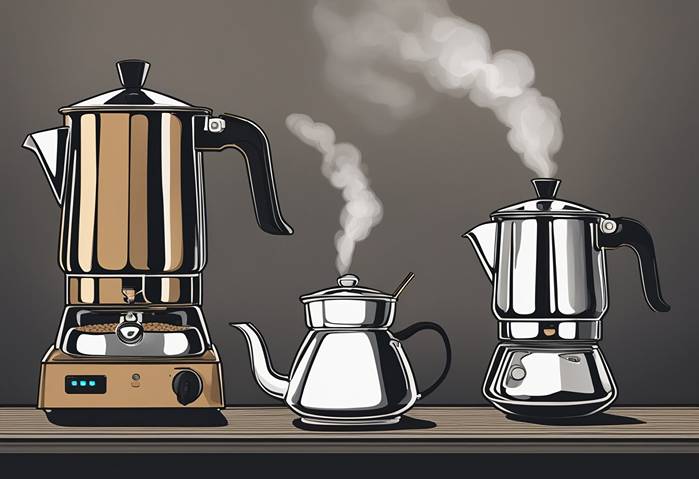
Flavor Differences
When it comes to flavor, the Moka Pot and the Percolator each cater to different tastes.
The Moka Pot produces an espresso-like brew, with a bold and intense flavor that can take your coffee cravings to new heights! It boasts a rich, slightly bitter taste, and a thick, delightful aroma.
On the other hand, the Percolator delivers a more traditional coffee taste. It creates a robust and full-bodied brew that captures the essence of coffee in a comforting way.
The resulting flavor is strong, yet smooth, with less bitterness than its Moka Pot counterpart.
Influence of Extraction
The key to these unique flavor profiles lies in the extraction process of each brewing system.
The Moka Pot uses high pressure to push water vapor through finely-ground coffee, leading to a richer, quicker extraction.
This brings out the boldness that defines its espresso-like taste.
Comparatively, the Percolator employs a slower, drip-like extraction method. Hot water trickles through medium-ground coffee, gently drawing the flavors and aromas of the beans.
This method lets you savor the essence of coffee without overpowering your taste buds with too much intensity.
As you can see, your choice between a Moka Pot and a Percolator comes down to your personal preferences in taste and extraction methods.
Happy brewing, and enjoy the unique coffee experiences each device offers!
Types of Coffee You Can Make

Get ready to brew delicious coffee drinks right in the comfort of your own home! You’ll find that Moka Pots and Percolators are classic ways to make amazing coffee beverages.
Discover the many types of coffee you can create using these two legendary devices.
Espresso-Type Coffee With Moka Pots
Your Moka Pot is the ideal brewing method for strong, concentrated coffee similar to espresso.
Although not identical to the espresso produced by traditional espresso machines, Moka Pot coffee possesses a rich and bold flavor that you’ll absolutely love.
The Moka Pot’s high-pressure brewing method coffee quickly pushes water vapor through finely-ground coffee, extracting the intense flavors of your favorite dark roasted beans.
This results in a remarkable espresso-like coffee with a beautiful crema on top.
With your Moka Pot, you can easily whip up delicious cappuccinos, lattes, and americanos that’ll make you feel like a barista in no time!
Diverse Coffee Recipes with Percolators
Your trusty Percolator, on the other hand, is a versatile coffee maker that allows you to brew a wide range of incredible coffee drinks.
You’ll love how the percolator slowly trickles water vapor through medium-ground coffee, creating a smoother and more balanced flavor.
Percolator coffee tastes are perfect for satisfying your cravings for classic black coffee, as well as experimenting with various coffee recipes.
Why not try your hand at crafting your own cappuccinos, lattes, or americanos by simply adding steamed milk or water to your percolated coffee? The opportunities are endless!
Now, get ready to explore the exciting world of coffee brewing with your Moka Pot and Percolator! Your taste buds will thank you!
Usability and Maintenance

Ease of Use
Moka pots and percolators both have their unique features when it comes to usability.
You’ll find that Moka pots are typically more convenient and portable due to their smaller size and simplicity.
They can whip up a rich and concentrated coffee in just 5-10 minutes, making it a perfect choice for those on-the-go!
Plus, Moka pots are designed to use on various stovetops, making them versatile in any kitchen.
On the other hand, percolators are great for brewing larger quantities of coffee – up to 20 minutes of brewing time.
However, this also means it can take longer to achieve those consistent results you’re craving, especially if you’re a enthusiast.
It’s worth noting that percolators require medium-ground coffee, while Moka pots need finely-ground coffee.
Cleaning and Care
When it comes to cleaning and maintenance, both Moka pots and percolators demand your attention.
For Moka pots, disassembling the device and rinsing each component under warm water is advisable.
Make sure you’re cautious around the rubber gasket, as it’s a sensitive part.
Occasionally, you might even need to replace the gasket.
Percolators require a bit more care, especially when they come with more components that need individual attention.
Cleaning the filter basket and interior tubing with warm water and mild detergent is essential.
Furthermore, you might want to descale your percolator regularly to prevent mineral buildup and ensure the longevity of your beloved coffee machine.
So, there you have it! Both Moka pots and percolators have their distinct usability and maintenance requirements.
Whichever you choose, just remember to keep your device clean and cared for to continue enjoying delicious cups of coffee every day!
Materials and Durability

Material Varieties in Moka Pots
If you’re into stovetop espresso makers, you’ll be thrilled by the variety of materials used in Moka pots! The most common material you’ll find is aluminum.
Aluminum Moka pots are lightweight, heat up quickly, and are quite affordable.
However, they might not be the most sustainable option and are less durable than stainless steel counterparts.
On the bright side, you can easily find replacement parts for aluminum Moka pots!
For those who prefer a slightly more eco-friendly option, you can opt for a stainless steel Moka pot.
Not only do they look sleek and elegant, but they are also corrosion-resistant and typically last longer than aluminum.
Moreover, they’re also considered safer since they don’t react with acidic coffee compounds.
Here’s a sample list of Moka pot materials:
- Aluminum
- Stainless steel
Materials in Percolators
As a coffee lover, you’ll be just as excited to know about the material varieties used in percolators! Similar to Moka pots, stainless steel is a popular material choice for coffee percolators.
These offer better heat retention, durability, and sustainability compared to aluminum percolators.
The filter basket, an essential part of any percolator, is often made of either stainless steel or aluminum.
Stainless steel filter baskets are superior in quality, retaining the flavor of your coffee without any metallic taste.
So, for your percolator, you could choose between:
- Stainless steel body with a stainless steel filter basket
- Stainless steel body with an aluminum filter basket
In conclusion, exploring the materials and durability of Moka pots and percolators is a fun adventure!
By understanding the differences in materials, you can make a more informed decision and find the perfect coffee maker that suits your preferences and needs. Happy brewing!
Comparing Cost and Value
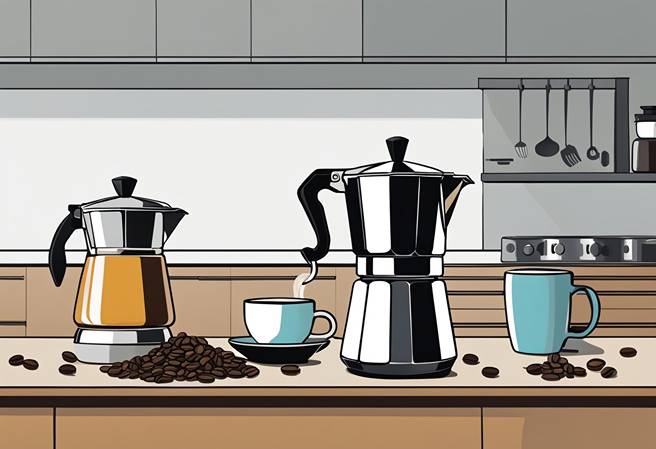
Price Points for Both Coffee Makers
When comparing the cost of Moka pots and percolators, you’ll find that both are quite budget-friendly!
Moka pots typically range in price from $20 to $50, while percolators can be found anywhere from $25 to $80.
It’s important to compare these options with the cost of espresso machines, which can range from a few hundred to several thousand dollars.
Considering price points: you can see that both Moka pots and percolators are considerably more affordable than espresso machines, making them great choices for your coffee brewing needs.
Long-term Value
When it comes to long-term value, the quality and durability of your coffee maker play a significant role.
Moka pots are generally made of aluminum or stainless steel, making them sturdy and able to withstand years of regular use.
Percolators are also designed for durability and can stand the test of time with proper care.
However, there are differences between the coffee flavors that these two devices produce.
Using a Moka pot produces coffee that is strong and rich, while percolators create coffee that is more like a drip coffee in terms of strength and flavor.
In terms of affordability and long-term value, both Moka pots and percolators offer great options given their budget-friendly prices and durability.
Ultimately, your choice between these two coffee makers comes down to personal preference for coffee flavor and brewing experience.
Enjoy discovering the perfect fit for your coffee cravings while staying within your budget!
Versatility and Adaptability

Moka Pots in Different Settings
Moka pots are fantastic for producing rich and bold coffee, perfect for those who love espresso-style drinks.
With their compact design, they’re ideal for small spaces or taking on-the-go.
Imagine brewing your favorite coffee in your tiny apartment, at the office, or even while camping!
One of the best features of the moka pot is its brewing technique. With a stovetop design, you can control heat levels and maintain precision while brewing.
You’ll be able to achieve that perfect cup of coffee, even if you’re far away from home.
- Convenient
- Portable
- Works on stovetop
- Great for camping, RVs, or small spaces
Percolators for Various Occasions
Percolators offer incredible flexibility when it comes to brewing coffee.
They provide a wide range of coffee styles, allowing you to explore mild to strong flavors.
This adaptability makes them a fantastic choice for any occasion, be it a simple breakfast or an elegant dinner party.
One of the key benefits of percolators is their ability to make several batches of coffee at once.
This means you can easily serve coffee to multiple guests, or even brew enough coffee for an entire day–perfect for large gatherings and family-style events.
Percolators are designed to work on various heat sources, including stovetops and campfires.
So, whether you’re at home, spending a weekend in your RV, or out camping, you can always count on a percolator to provide a delicious and satisfying cup of coffee.
- Adaptable
- Brews multiple batches
- Works on stovetop, campfires, and other heat sources
- Great for home, RV, or camping use
Advantages and Disadvantages
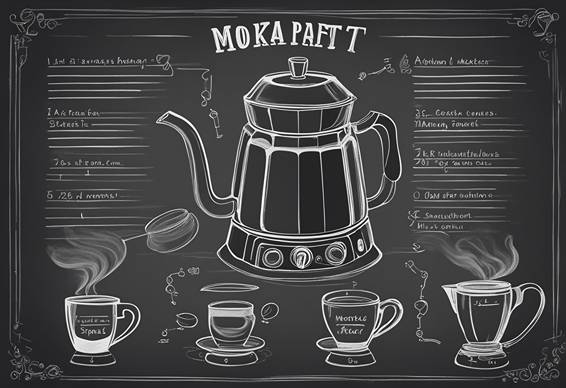
Pros and Cons of Moka Pots
Moka pots are a popular choice for coffee lovers seeking a rich, strong brew similar to coffee espresso.
The brewing coffee beans process used by the Moka pot generates high pressure, pushing water vapor through finely-ground coffee to create a robust flavor.
There are several advantages of using Moka pots:
- Simplicity: Brewing with a Moka pot is quite straightforward – you can easily measure the exact amount of coffee and water.
- Affordability: Moka pots are a budget-friendly alternative to expensive espresso machines.
However, Moka pots also have some drawbacks:
- Limited brewing size: Moka pots are available in preset sizes, which means you can’t brew more or less coffee on a whim.
- Requires close attention: To get the best results, you need to closely monitor the brewing process to ensure proper extraction.
Pros and Cons of Percolators
Percolators, on the other hand, are a classic coffee brewing method that produces a full-bodied cup.
Through a more slow-paced brewing process, water vapor trickles through medium-ground coffee in a percolator.
Here are some advantages of using a percolator:
- Ease of use: Percolators are user-friendly and easy to maintain, making them an attractive choice for many coffee enthusiasts.
- Large quantity: Percolators can brew large quantities of coffee at once, which is perfect for those with a large household or when hosting guests.
However, percolators have their own set of disadvantages:
- Risk of over-extraction: If not monitored closely, percolators can produce bitter and over-extracted coffee.
- Temperature control: Percolators can sometimes overheat the coffee, causing it to lose flavor.
In conclusion, when choosing between a Moka pot and a percolator, it ultimately depends on your taste preferences and requirements.
Both coffee makers have their own unique advantages and disadvantages, so it’s up to you to decide which brewing method best suits your needs and produces the perfect cup of coffee for you to enjoy!
| Feature | Moka Pot | Percolator |
|---|---|---|
| Brewing Method | Uses steam pressure to brew coffee | Recirculates boiling water through grounds |
| Brewing Time | Typically brews coffee in 5-10 minutes | Brews coffee in 5-15 minutes |
| Coffee Strength | Produces strong, concentrated coffee | Can produce a range of strengths depending on brew time and grind size |
| Grind Size | Uses finely ground coffee | Works with coarser grinds |
| Capacity | Usually smaller, typically up to 6 cups | Can range from small (4 cups) to large (12+ cups) |
| Ease of Use | Simple to use with minimal parts | Requires monitoring of brew time and water level |
| Portability | Compact and portable | Can be bulky, especially larger models |
| Cleaning | Easy to disassemble and clean | Requires thorough cleaning of multiple parts |
| Cost | Generally more affordable | Can vary widely depending on size and features |
Conclusion
When delving into the world of brewing coffee at home, the moka pot and coffee percolator stand out as two distinguished methods, each offering a unique way to make coffee.
The difference between a moka pot and a coffee percolator lies in their brewing techniques, the type of coffee they produce, and the process involved in making coffee.
Moka pots are renowned for their ability to make concentrated coffee, often likened to espresso coffee due to the pressure to brew coffee.
They utilize finely ground coffee, directing steam pressure through the coffee grounds to produce strong coffee that’s rich in flavor.
This method is ideal for those who appreciate a robust cup of coffee similar to an espresso but without the need for an espresso machine.
Moka pots make coffee that is intense and full-bodied, a specialty coffee experience from the comfort of your home.
On the other hand, percolators brew coffee by cycling boiling water through coffee grounds located in a coffee basket, often resulting in a hotter and longer brewing process.
This can sometimes make the coffee bitter if left brewing for too long.
Percolators are great for brewing large batches of coffee, making them a good choice for serving multiple people at once.
The coffee percolator has been a classic coffee pot in many households, known for its simplicity and effectiveness in brewing rich coffee.
Both devices are among the best ways to make coffee, offering distinct tastes and experiences.
The moka pot is praised for producing better-tasting coffee with a consistency similar to espresso, while percolators and moka pots both have their place among coffee lovers for different reasons.
Whether you prefer the stronger coffee from a moka pot or the larger quantity and ease of a coffee percolator, both methods showcase the traditional and rich coffee brewing techniques outside of the modern coffee gadgets like drip coffee makers and French press coffee.
Choosing between a moka pot and a coffee percolator ultimately comes down to personal preference regarding the taste and method of brewing.
While moka pots are one of the best coffee methods for those who enjoy espresso-like strength and flavor, percolators offer a nostalgic and straightforward approach to brewing the coffee that will satisfy anyone looking to make delicious coffee in larger quantities.
Frequently Asked Questions
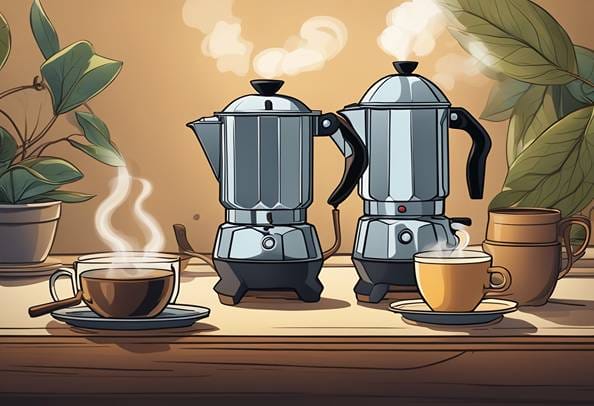
What’s the taste difference between coffee from a Moka pot and a Percolator?
The taste of coffee from a Moka pot and a Percolator can be quite different.
Moka pots use high pressure to quickly push water vapor through finely-ground coffee, resulting in a strong and bold flavor often compared to espresso.
On the other hand, percolators allow the water vapor to slowly trickle through medium-ground coffee, producing a milder taste, yet it can sometimes be over-extracted, causing bitterness.
How do brewing times compare between Moka pots and Percolators?
Moka pots tend to have a faster brewing time compared to percolators.
The high-pressure brewing process in Moka pots often takes about 5-10 minutes, depending on the size and heat source.
Percolators, which use a slower brewing process, typically require 10-20 minutes for a full brewing cycle.
Can I make authentic espresso with a Moka pot or do I need a Percolator?
Neither Moka pots nor percolators can produce authentic espresso like an espresso machine, as coffee they make they operate under lower pressure levels.
However, Moka pots come closer to replicating the espresso experience because of their stronger and bolder coffee flavor.
What are the pros and cons of using an electric Moka pot over a traditional Percolator?
Electric Moka pots offer convenience and ease of use, with features like automatic shut-off and temperature control.
This can help you avoid over-extraction and achieve a consistent brewing experience.
Traditional percolators, especially stovetop versions, require more attention and care during brewing to prevent over-extraction and bitterness in your coffee.
Which lasts longer, a stainless steel Moka pot or a Percolator?
Both stainless steel Moka pots and percolators are known for their durability and longevity.
However, the quality of these products can vary greatly depending on the brand and materials used.
It’s essential to invest in a high-quality stainless steel device, regardless of whether you choose a Moka pot or a percolator, to ensure it lasts longer.
Is it true that coffee from a Moka pot is stronger than from a Percolator?
Yes, it’s generally true that coffee brewed using a though Moka pot coffee is strong, stronger than that from a percolator.
The higher pressure and faster brewing process in Moka pots extract a more concentrated flavor, resulting in a bolder and more robust coffee.

